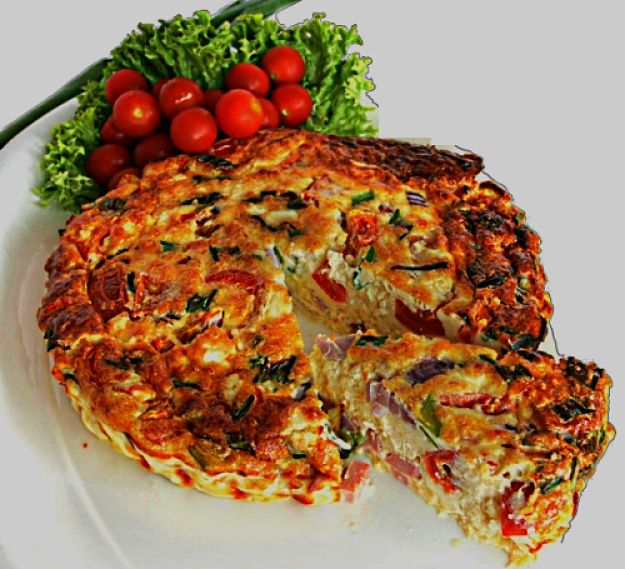Healthy Frittata Recipe with Fresh Garlic, Greens for Snacks, Picnics

Homemade Fittata Recipe with garlic and greens - healthy and delicious
Itzuvit [Public Domain], via Wikimedia Commons
Frittatas are filling stuffed omelettes, Italian-style, made with chopped meats, herbs, fresh leafy greens and spices. They can be eaten straight away, but they also are delightful when served chilled for snacks and picnics. Simply cut into squares and store in sealed containers in the fridge. They can be warmed using a microwave, but they are nice cold with meats and salads, especially as a side serve for summer barbecues.
Adding fresh greens really boosts the flavor, color, texture and nutrients in your frittata. You decide how finely you chop the greens and how much you want to include. A wide variety of greens can be used, and try to include two or three to add interest and flavor. Try spinach, baby beet greens, kale, chard and many others. You can also add fresh herbs such as coriander, basil and broad leaf parsley. If you add onions, be sure to fry first until transparent and softened a little. Cooking can be tricky as the onions can tend to burn when cooking the omelettes, so chop very finely.
Ingredients for Frittata
4 fresh free range eggs
1 tablespoon milk
3/4 to 1 cup finely chopped blanched fresh greens
2 teaspoons of rice bran oil, grape seed oil, or another high smoke point oil, with a neutral taste. You can use extra virgin olive oil, if you like the taste.
1- 2 tablespoon freshly grated Parmesan
1 garlic clove, minced or pureed
Salt and freshly ground pepper to taste
Fresh herbs and spices (optional)
Method
Whisk the eggs in a bowl, and season with pepper and salt to taste. Add the greens, garlic and Parmesan (you choose the amount). Heat the oil in a heavy frying pan over medium-high heat. Test for the right temperature by dropping a small amount of the egg mixture into the oil. If it sizzles and cooks straight away it is at the right temperature. Having a heavy thick pan at the right temperature is critical. A thick pan stores heat so the temperature does not drop when you add the omelette mixture.
Pour in the egg mixture (in two batches for a smaller pan). Lift the pan, tilt and swirl the pan to spread the egg mixture so it forms a thin layer over the surface. Let the eggs set and start to cook underneath for a few minutes of cooking. The omelette is not flipped over, but the top is cooked slowly in the covered pan. Using a spatula test that the bottom layers of egg cooked and just started to brown slightly. Turn the heat down to low, cover the pan and let slowly cook for 7-12 minutes. Periodically slip a spatula under the omelette to make sure it is not burning. If this starts to happen, drizzle a tiny amount of oil under the omelete, or flip over. The top of the frittata will become puffed and set. Don't overcook, and remember that the cooking will continue even when the frittata
is removed from the pan onto as serving plate. If you overcook the frittata it will become leathery and tough.
Remove from the pan, allow to cool a little before serving. Cut into 4 wedges or squares for serving or refrigerating for snacks, picnics or barbecues. Each batch will keep for 3-5 days in a covered container in the fridge.
Nutrition Summary
Nutritional data for one serve (1/4 of the mixture): 202 calories; 2 g carbohydrates; 14 g protein; 15 g fat; 7 g mono-unsaturated fat; 4 g saturated fat; 2 g polyunsaturated fat; 375 mg cholesterol; about 2 g fiber; 190 mg sodium.